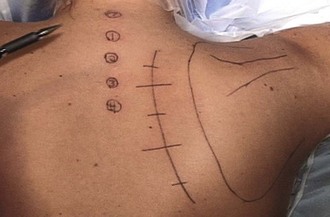Chapter 32 The scapulothoracic articulation is one of four joints that work in concert to allow the shoulder to have the greatest range of motion of any joint in the body. Scapulothoracic motion is a significant contributor because it helps account for one third of shoulder elevation. Causes of dysfunction of the scapulothoracic joint can essentially be broken into two categories: dystrophic and nondystrophic. The primary dystrophic cause is facioscapulohumeral dystrophy (FSHD). Nondystrophic causes include peripheral nerve injury, failed tendon transfers for nerve injury, brachial plexus injuries, and stroke. These conditions ultimately alter the stability of the scapular platform and affect glenohumeral motion. Commonly this manifests as scapular winging and loss of shoulder motion that lead to pain. Scapulothoracic arthrodesis has been described as a viable salvage operation.1,2 The goal of this procedure is to create a solid union between the anterior surface of the scapula and the posterior thorax to stabilize this articulation, restore some level of function, and alleviate pain.3 At presentation, patients may have FSHD—a genetic disorder that leads to progressive muscular weakness and muscle loss and primarily affects face, shoulder, and upper arm muscles. This condition affects about 5 per 100,000 people. Genetic studies often demonstrate a deletion in the long arm of chromosome 4. Facial symptoms often accompany this condition and can vary from ptosis to speech problems.4 Brachial plexus injuries from birth or recent trauma may be noted. Trauma or other conditions may be elucidated that have lead to muscle injury or peripheral nerve injury. Surgical landmarks that should be marked before the procedure include the spinous processes of C7 to T4, the associated thoracic ribs, and the superior, medial, and lateral borders of the scapula (Fig. 32-1). Typically with the arm positioned as described earlier, the spine of the scapula overlies the fourth rib and the scapula is rotated approximately 30 degrees in relation to the spinous processes.
Scapulothoracic Fusion
Preoperative Considerations
Surgical Procedure
Surgical Landmarks
![]()
Stay updated, free articles. Join our Telegram channel

Full access? Get Clinical Tree


Scapulothoracic Fusion







